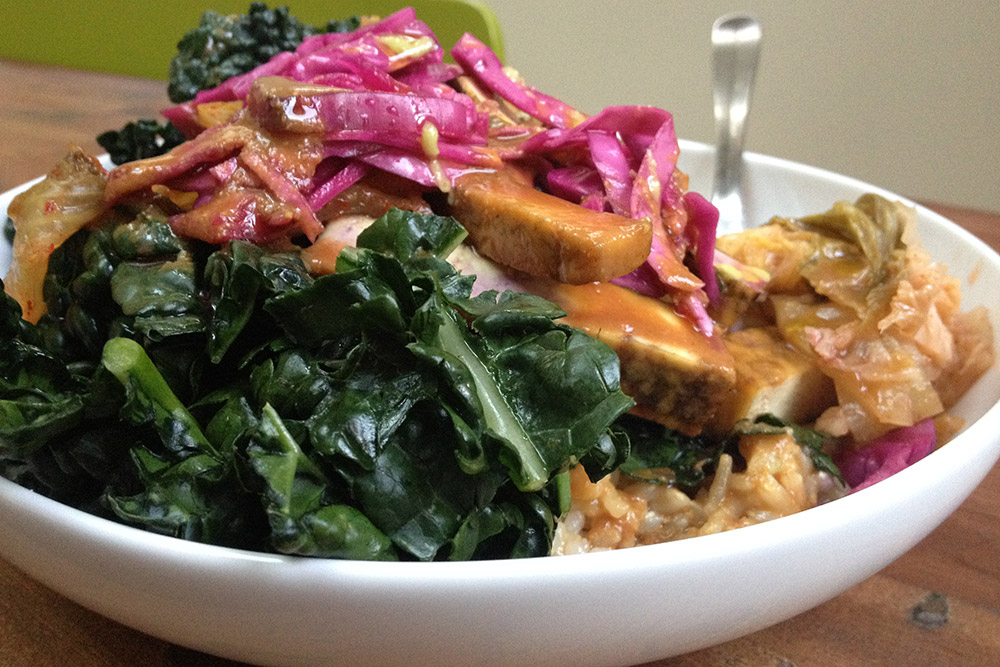Much against the advice of friend and author, Tamar Aniati, who wrote a piece for Tue/Night last year entitled ‘On Greens: Can We Please Stop Talking About Kale Now?’, we currently feel the strong need to talk about kale.
We have no intention of addressing the social implications of the prevalence of kale on our society as Tamar did so eloquently and exasperatedly. Instead, we feel we must address how this common food staple—in both homes and restaurants—is still so inadequately prepared in this day and age.
Far too often have we dined out and ordered a kale salad only to receive a bland plate of barely touched, uncooked, raw kale with a random assortment of vegetables, dressings, and other haphazard salad accoutrements atop it. Far too often have we fielded the question of how we prepare our kale not quite wanting to end up with a stove-top cooked-down side dish, but also wanting to end up with something…edible.
So, we’re out to put an end to it all…hopefully without sounding like assholes. Here’s all you need to do with your kale.
1. Thoroughly wash your kale—be it ‘dinosaur’ kale or black kale or ‘KALE no’ kale—slice off the bottom inch or so of each leaf, and then carefully chop the leaves and remaining tender stems into roughly two-inch segments. I write ‘carefully’ because it’s easy, when pulling the leaves into a compressed bunch on the cutting board, to get a finger caught in there. I’ve certainly done it a couple times.
2. Set aside in a bowl that’s large enough to hold the kale and then some.
3. Now you need your acid, salt, and/or oil. Essentially, the idea is to add a pleasing flavor that also chemically helps break down the cell walls of the kale, rendering it more enjoyable to eat and more able to play well with others on the plate. You can use a number of things here—mix juice from one lemon and a tablespoon of good olive oil in a small bowl; or you can salt the leaves, allow the salt to break down the kale like it would when making a pickle, then rinse the kale to rid it of most of the salty taste; or you can mix equal parts toasted sesame oil, soy sauce, and rice vinegar in a bowl; or you can mix a tablespoon of miso with apple cider vinegar and a little olive oil. Point being—experiment. Just do so in a smaller bowl and taste it before adding it to the bowl. But, basically, you just need an acid (citrus or vinegar) and/or quality oil and/or salt. All of it works, so get creative.
4. Once you’ve settled on a flavor/kale-buster, add gradually to the larger bowl of kale and them get your hands in there, turning and crunching up the kale with the marinade, allowing it to seep into the leafy vegetable and stems. Don’t worry about being rough with the stuff—you can’t really hurt it at this point. Carefully turn over as you do this (don’t douse your shirt in marinade) and watch as it begins to lose volume and soften up. Once it seems pretty thoroughly covered, taste to make sure you don’t need more marinade, set aside and get on to the rest of your meal. Return just before plating and give it another quick touching up.
Now you’re pretty much good to go. Pair with rice and a protein, make a nice kale salad with complimentary toppings, add a s nice side to a meal, or top your favorite sandwich—it’s great with some seasoned tempeh, roasted yam, and Veganaise on good bread.
Pictured below, last night’s kale atop brown rice with grilled tofu, kimchi, wasabi oil, and picked vegetables.




